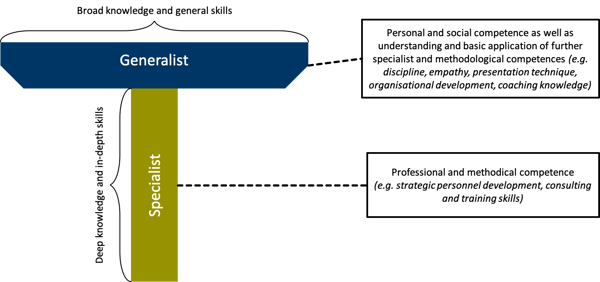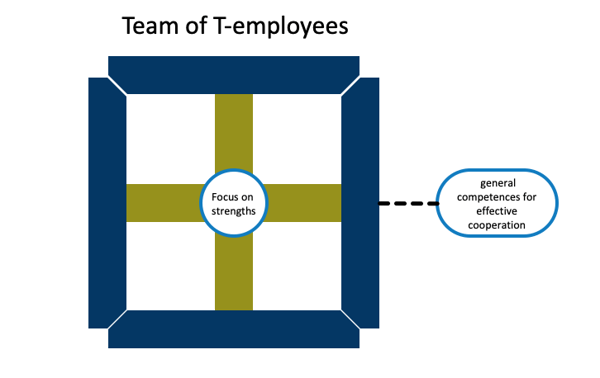Leadership in an agile world (9): crossfunctional teams
Today's working world is characterised by rapid change. The resulting complex challenges demand a high degree of insight, determination and creativity from us. This often requires a mental change, a change of perspective and a change of attitude in order to generate solutions and master the challenges.
In this context, it is important that managers do not see themselves as omniscient, but as organisers of cooperation. It is essential to rely on different expertise in the team and to give responsibility for content. This type of cooperation is excellent in cross-functional teams.
What are cross-functional teams?
Cross-functional teams have all the disciplines in view that they need to successfully implement their project. All team members are specialists in their fields. In addition, however, they also have a general understanding of projects, processes, economic relationships and the broadest possible basic knowledge so that they can take on other tasks as well.
In the literature these employees are also called T-employees or T-shaped professionals. The background for this is the "T-shape" model (see figure 1), which was already the basis for employee development and development at IBM in the mid-1990s. Such employees combine the strengths of the generalist and the specialist.
Especially in a VUCA context, T-employees are very effective at solving challenges of the agile world efficiently and creatively and have a clear added value compared to pure specialists or pure generalists due to their competence profile.

Figure 1: T-employees (Kallenbach 2016, p. 280)
How can a cross-functional team be set up?
The first step is to identify the strengths of the team. As a manager, you should support employees in identifying their strengths. What are the strengths of your employees? What does your employee do particularly well? What is easy for him? What does he like to do?
Only then does the focus have to be: How can these strengths be promoted? In which projects and situations can employees develop their strengths? Starting from the identification of strengths and the subsequent focus on strengths, you should develop a further training concept for your team in which you orient yourself to the strengths of the employees. However, the focus should also be on the development of social and personal skills as well as more general abilities.
Possibilities for this are, of course, further education, training and workshops, but also an internal knowledge transfer structure in which employees share special and generalist knowledge and are thus more broadly positioned. In addition, this also promotes that a sickness or holiday situation can be absorbed well.
Based on the perspective of what the needs of the market and the customers are and what leads to the highest possible added value, you develop cross-functional teams that exploit great potential through the strengths of the T-employees (see figure 2).

Figure 2: Team of T-employees (Kallenbach 2016, p. 281)
Hurdles in building cross-functional teams
Which hurdles make it more difficult or impede the development of cross-functional teams? What should be considered in the internal company context?
No common culture:
For an optimal exploitation of the added value of cross-functional teams, it is enormously important that the corporate culture is value-based. Only through a common culture can elementary prerequisites such as consistently high transparency, an attitude of trust, team self-organisation and effective feedback mechanisms exist.
Without the presence of these elements, T-Shaped teams will not realize their full potential. The decisive prerequisite for the culture lived in the company is the role model of the manager.
Inadequate development of potential
To unfold potential begins with identifying the existing and available possibilities. In addition, these possibilities must then be actively promoted through a suitable context design and further developed systematically.
By designing the context in such a way that talent, motivation and learning agility are promoted, a good basis for full potential development is given.
Those responsible, who only once a year, shortly before the annual appraisal interview, have a rough look at the obvious strengths and weaknesses of their employees, will never promote the potential of the employee, the team and the entire organisation and will never achieve the existence of a cross-functional team.
Inefficient processes
In the VUCA world, constant changes in environmental conditions create the challenge of developing processes that can adapt to rapidly changing conditions.
These agile processes enable continuous interaction between the participants and create a high level of transparency. Continuous improvement is ensured by reflection loops, which are an integral part of these processes. It is precisely in these processes that cross-functional teams show their strengths.
On the other hand, process developments without the involvement of the participants are not oriented towards direct events, as the people closest to them are neglected. As a result, the impact of the processes is not efficient.
Conclusion
Cross-functional teams are a strong response to the challenge of the VUCA world. As a leader, you can develop efficient teams consisting of T-employees whose strength lies in expert and broad knowledge. In this context, a common corporate culture, holistic potential development systems and agile processes are elementary under many other important conditions.
Are you interested in the topic of cross-functional teams or would you like to learn more about the development of T-employees? Then you are welcome to inform yourself about our services in this area or simply contact us.
Further blog posts from the series "Leadership in an agile world":
Leading in an agile world (1): the concept of agility
Leadership in an agile world (2): "working out loud"
Leadership in an agile world (3): scrum
Leadership in an agile world (4): barcamps
Leadership in an agile world (5): retrospectives
Leadership in an agile world (6): peer feedback
Leadership in an agile world (7): transparency
Leadership in an agile world (8): Delegation Poker
Leadership in an agile world (9): crossfunctional teams
Leadership in an agile world (10): face time
Literature
Kallenbach, Ingo (2016). Leadership in a Healthy Organisation. Exceptional performance through potential development. Stuttgart: Schäffer-Poeschel.
Hofert, Svenja (2018). Leading more agilely. Simple measures for better teamwork, more performance and higher creativity. Wiesbaden: Springer Gabler

